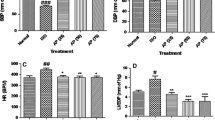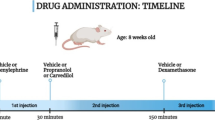Abstract
Sustained high levels of circulating catecholamines are reported to induce cardiotoxicity. Isoproterenol (ISP), a synthetic catecholamine has been widely employed to induce myocardial injury, though the role of inflammation and apoptosis is not well established. This study was designed to investigate the underlying mechanism of oxidative damage, inflammatory signaling, cell death in ISP induced myocardial infarction in rats. Wistar albino rats were divided in two groups: group I (sham control) and group II (ischemic control). ISP (85 mg/kg, s.c.) was administered at an interval of 24 h to group II for two consecutive days. On day third, after 48 h of the first injection of ISP, blood was collected from retro orbital plexus of rat eyes to estimate the biochemical parameters. Glutathione (GSH) and superoxide dismutase (SOD) were measured for antioxidant status. Similarly, malondialdehyde (MDA) was measured as an index of lipid peroxidation. Cardiac markers (SGOT, CK-MB, TropI and LDH) and pro-inflammatory cytokines (IL-6, CRP and TNF-α) were also estimated in ISP-induced rats. At the end of experiments animals were sacrificed for histopathological studies. GSH and SOD showed significant decrease after ISP challenge as compared to sham (control) group (p < 0.01) while MDA level, increased significantly (p < 0.01). ISP, also increased the level of cardiac markers and markers of inflammation significantly (p < 0.01), which was further verified by histopathological studies of the heart tissues. The study confirmed that ISP causes detrimental changes in the myocardium by altering cardiac and inflammatory markers, which leads to severe necrosis. The deleterious effects produced by ISP substantiate its suitability as a novel animal model for evaluation of cardioprotective agents/drugs.








Similar content being viewed by others
References
Weir RA, McMurray JJ. Epidemiology of heart failure and left ventricular dysfunction after acute myocardial infarction. Curr Heart Fail Rep. 2006;3:175–80.
Dhalla NS, Temsah RM, Netticadan T. Role of oxidative stress in cardiovascular diseases. J Hypertens. 2000;18:655–73.
Ojha SK, Nandave M, Arora S, Narang R, Dinda AK, Arya DS. Chronic administration of Tribulus terrestris Linn. extract improves cardiac function and attenuates myocardial infarction in rats. Int. J Pharmacol. 2008;4:1–10.
Mainzen Prince PS, Kumar R, Selvakumari CJ. Effects of gallic acid on brain lipid peroxide and lipid metabolism in streptozotocin-induced diabetic Wistar rats. J Biochem Mol Toxicol. 2011;25:101–7.
Punithavathi VR, Shanmugapriya K, Mainzen Prince PS. Protective effects of rutin on mitochondrial damage in isoproterenol-induced cardiotoxic rats: an in vivo and in vitro study. Cardiovas Toxicol. 2010;10:181–9.
Rona G, Chappel CI, Balazs T, Gaudry R. An infarct-like myocardial lesion and other toxic manifestations produced by isoproterenol in the rat. AMA Arch Pathol. 1959;67:443–5.
Beznak M. Hemodynamics during the acute phase of myocardial damage caused by isoproterenol. Can J Biochem Physiol. 1962;40:25–30.
Shizukuda Y, Buttrick PM, Geenen DL, Borczuk AC, Kitsis RN, Sonnenblick EH. beta-adrenergic stimulation causes cardiocyte apoptosis: influence of tachycardia and hypertrophy. Am J Physiol. 1998;275:961–8.
Nirdlinger EL, Bramante PO. Subcellular myocardial ionic shifts and mitochondrial alterations in the course of isoproterenol-induced cardiopathy of the rat. J Mol Cell Cardiol. 1974;6:49–60.
Li L, Zhang LK, Pang YZ, Pan CS, Qi YF, Chen L, et al. Cardioprotective effects of ghrelin and des-octanoyl ghrelin on myocardial injury induced by isoproterenol in rats. Acta Pharmacol Sin. 2006;27:527–35.
Goyal SN, Arora S, Sharma AK, Joshi S, Ray R, Bhatia J, et al. Preventive effect of crocin of Crocus sativus on hemodynamic, biochemical, histopathological and ultrastuctural alterations in isoproterenol-induced cardiotoxicity in rats. Phytomedicine. 2010;17:227–32.
Mohanty IR, Arya DS, Gupta SK. Wthania somnifera provides cardioprotection and attenuates ischemia-reperfusion induced apoptosis. Clin Nutr. 2008;27:635–42.
Yeager JC, Lams SG. The hemodynamics of isoproterenol induced cardiac failure in the rat. Circ Shock. 1981;8:151–63.
Satoh K. Serum lipid peroxide in cerebrovascular disorder determined by a new colorimetric method. Clin Chem Acta. 1978;90:37–43.
Marklund S, Marklund G. Involvement of the superoxide anion radical in the autooxidation of pyrogallol and a convenient assay for superoxide dismutase. Eur J Biochem. 1974;47:469–74.
Nandi A, Chatterjee B. Assay of superoxide dismutase activity in animal tissues. J Biosci. 1988;13:305–15.
Beutler E, Duron O, Kelly BM. Improved method for the determination of blood glutathione. J Lab Clin Med. 1963;61:882–8.
Gavrieli Y, Sherman Y, Ben-Sasson SA. Identification of programmed cell death in situ via specific labeling of nuclear DNA fragmentation. J Cell Biol. 1992;119:01–493.
Jaffe AS, Landt Y, Parvin CA, Abendschein DR, Geltman EM, Ladenson JH, et al. Comparative sensitivity of cardiac troponin I and lactate dehydrogenase isoenzymes for diagnosing acute myocardial infarction. Clin Chem. 1996;42:1770–6.
Priscilla DH, Prince PS. Cardioprotective effect of gallic acid on cardiac troponin-T, cardiac marker enzymes, lipid peroxidation products and antioxidants in experimentally induced myocardial infarction in Wistar rats. Chem Biol Interact. 2009;179:118–24.
Bertinchant JP, Robert E, Polge A, Marty-Double C, Fabbro-Peray P, Poirey S, et al. Comparison of the diagnostic value of cardiac troponin I and T determinations for detecting early myocardial damage and the relationship with histological findings after isoprenaline-induced cardiac injury in rats. Clin Chim Acta. 2000;298:13–28.
Wallace KB, Hausner E, Herman EH, Holt GD, MacGregor JT, Metz AL, et al. Serum troponin as biomarkers of drug-induced cardiac toxicity. Toxicol Pathol. 2004;32:106–21.
Farvin KHS, Anandan R, Kumar SHS, Shiny KS, Mathew S, Sankar TV, et al. Cardioprotective effect of squalene on lipid profile in isoprenaline-induced myocardial infarction in rats. J Med Food. 2006;9:531–6.
Kumar S, Seth S, Jaiswal A, Enjamoori R, Dinda AK, Ray R, et al. Chronic β-adrenergic activation-induced left ventricular systolic dysfunction is associated with systemic release of TNF-α and IL-1-β in rats. Pharmacol Rep. 2009;61:870–6.
Kawaguchi M, Takahashi M, Hata T, Kashima Y, Usui F, Morimoto H, et al. Inflammasome activation of cardiac fibroblasts is essential for myocardial ischemia/reperfusion injury. Circulation. 2011;123:4–594.
Arslan F, Smeets MB, O’Neill LA, Keogh B, McGuirk P, Timmers L, et al. Myocardial ischemia/reperfusion injury is mediated by leukocytic toll-like receptor-2 and reduced by systemic administration of a novel anti-toll-like receptor-2 antibody. Circulation. 2010;121:80–90.
Haunstetter A, Izumo S. Apoptosis: basic mechanism and implication for cardiovascular disease. Circ Res. 1998;82:1111–29.
Haunstetter A, Izumo S. Future perspectives and potential implications of cardiac myocyte apoptosis. Cardiovas Res. 2000;45:795–801.
Green DR, Reed JC. Mitochondria and apoptosis. Science. 1998;281:1309–12.
Narula J, Pandey P, Arbustini E, Haider N, Narula N, Kolodgie FD, et al. Apoptosis in heart failure: release of cytochrome c from mitochondria and activation of caspase-3 in human cardiomyopathy. Proc Natl Acad Sci USA. 1999;96:8144–9.
Author information
Authors and Affiliations
Corresponding author
Rights and permissions
About this article
Cite this article
Shukla, S.K., Sharma, S.B. & singh, U.R. β-Adrenoreceptor Agonist Isoproterenol Alters Oxidative Status, Inflammatory Signaling, Injury Markers and Apoptotic Cell Death in Myocardium of Rats. Ind J Clin Biochem 30, 27–34 (2015). https://doi.org/10.1007/s12291-013-0401-5
Received:
Accepted:
Published:
Issue Date:
DOI: https://doi.org/10.1007/s12291-013-0401-5




